Simulation of Flood-Induced Human Migration at the Municipal Scale: A Stochastic Agent-Based Model of Relocation Response to Coastal Flooding
Abstract
1. Introduction
2. Materials and Methods
2.1. Study Area
2.2. Baseline Model
2.2.1. Data Sources
2.2.2. Individuals’ Behavior and Decision Making
2.2.3. Baseline Model Calibration
2.3. Flood-Informed Model
2.3.1. Physical Flood Inundation Modeling
- Storyline 1: Frequent small floods (with a return period of 2–10 years).
- Storyline 2: Frequent small floods and one severe storm (with a return period of 100 years or more) occurring early in the horizon (within the first 15 years).
- Storyline 3: Frequent small floods, one large storm (with a return period of 10–100 years), and two severe storms (with a return period of 100 years or more) occurring late in the horizon (within the last 15 years).
- Storyline 4: Frequent nuisance flooding, one large storm (with a return period of 10–100 years), and three severe storms (with a return period of 100 years or more).
2.3.2. Adjustment of Decision Rules
2.3.3. Model Simulations and Analysis
3. Results
3.1. Baseline Model Calibration
3.2. Flood-Informed System Behavior
4. Discussion
5. Conclusions
Supplementary Materials
Author Contributions
Funding
Data Availability Statement
Conflicts of Interest
References
- Cairns, G.; Ahmed, I.; Mullett, J.; Wright, G. Scenario method and stakeholder engagement: Critical reflections on a climate change scenarios case study. Technol. Forecast. Soc. Change 2013, 80, 1–10. [Google Scholar] [CrossRef]
- Döös, B.R. Environmental Degradation, Global Food Production, and Risk for Large-Scale Migrations. Ambio 1994, 23, 124–130. [Google Scholar]
- Hugo, G. Environmental Concerns and International Migration. Int. Migr. Rev. 1996, 30, 105–131. [Google Scholar] [CrossRef]
- MacKellar, F.L.; Lutz, W.; McMichael, A.J.; Suhrke, A. Population and Climate Change; Rayner, S., Malone, E.L., Eds.; Battelle Press: Columbus, OH, USA, 1998; Available online: https://iiasa.dev.local/ (accessed on 23 November 2023).
- Magadza, C. Climate Change Impacts and Human Settlements in Africa: Prospects for Adaptation. Environ. Monit. Assess. 2000, 61, 193–205. [Google Scholar] [CrossRef]
- Meze-Hausken, E. Migration caused by climate change: How vulnerable are people in dryland areas? Mitig. Adapt. Strateg. Glob. Change 2000, 5, 379–406. [Google Scholar] [CrossRef]
- Myers, N. Environmental refugees: A growing phenomenon of the 21st century. Philos. Trans. R. Soc. Lond. Ser. B Biol. Sci. 2002, 357, 609–613. [Google Scholar] [CrossRef] [PubMed]
- de Sherbinin, A.; VanWey, L.K.; McSweeney, K.; Aggarwal, R.; Barbieri, A.; Henry, S.; Hunter, L.M.; Twine, W.; Walker, R. Rural household demographics, livelihoods and the environment. Glob. Environ. Change 2008, 18, 38–53. [Google Scholar] [CrossRef]
- Owen-Burge, C. Climate Refugees—The World’s Forgotten Victims [Internet]. Climate Champions. 2021. Available online: https://climatechampions.unfccc.int/climate-refugees-the-worlds-forgotten-victims/ (accessed on 16 January 2023).
- Massey, D.S. A Missing Element in Migration Theories. Migr. Lett. 2015, 12, 279–299. [Google Scholar] [CrossRef]
- Lee, E.S. A theory of migration. Demography 1966, 3, 47–57. [Google Scholar] [CrossRef]
- Black, R.; Adger, W.N.; Arnell, N.W.; Dercon, S.; Geddes, A.; Thomas, D. The effect of environmental change on human migration. Glob. Environ. Change 2011, 21, S3–S11. [Google Scholar] [CrossRef]
- Hunter, L.M.; Luna, J.K.; Norton, R.M. Environmental Dimensions of Migration. Annu. Rev. Sociol. 2015, 41, 377–397. [Google Scholar] [CrossRef] [PubMed]
- McLeman, R.A. Climate and Human Migration: Past Experiences, Future Challenges; Cambridge University Press: Cambridge, UK, 2014; p. 313. [Google Scholar]
- Piguet, E. Linking climate change, environmental degradation, and migration: A methodological overview. WIREs Clim. Change 2010, 1, 517–524. [Google Scholar] [CrossRef]
- Bohra-Mishra, P.; Oppenheimer, M.; Hsiang, S.M. Nonlinear permanent migration response to climatic variations but minimal response to disasters. Proc. Natl. Acad. Sci. USA 2014, 111, 9780–9785. [Google Scholar] [CrossRef] [PubMed]
- Feng, S.; Krueger, A.B.; Oppenheimer, M. Linkages among climate change, crop yields and Mexico–US cross-border migration. Proc. Natl. Acad. Sci. USA 2010, 107, 14257–14262. [Google Scholar] [CrossRef] [PubMed]
- Gray, C.L.; Mueller, V. Natural disasters and population mobility in Bangladesh. Proc. Natl. Acad. Sci. USA 2012, 109, 6000–6005. [Google Scholar] [CrossRef] [PubMed]
- Gray, C.; Wise, E. Country-specific effects of climate variability on human migration. Clim. Change 2016, 135, 555–568. [Google Scholar] [CrossRef]
- Marchiori, L.; Maystadt, J.-F.; Schumacher, I. The impact of weather anomalies on migration in sub-Saharan Africa. J. Environ. Econ. Manag. 2012, 63, 355–374. [Google Scholar] [CrossRef]
- Mastrorillo, M.; Licker, R.; Bohra-Mishra, P.; Fagiolo, G.; Estes, L.D.; Oppenheimer, M. The influence of climate variability on internal migration flows in South Africa. Glob. Environ. Change 2016, 39, 155–169. [Google Scholar] [CrossRef]
- Mueller, V.; Gray, C.; Kosec, K. Heat stress increases long-term human migration in rural Pakistan. Nat. Clim. Change 2014, 4, 182–185. [Google Scholar] [CrossRef]
- Thiede, B.C.; Gray, C.L. Heterogeneous climate effects on human migration in Indonesia. Popul. Environ. 2017, 39, 147–172. [Google Scholar] [CrossRef]
- Kniveton, D.; Smith, C.; Wood, S. Agent-based model simulations of future changes in migration flows for Burkina Faso. Glob. Environ. Change 2011, 21, S34–S40. [Google Scholar] [CrossRef]
- Hauer, M.E. Migration induced by sea-level rise could reshape the US population landscape. Nat. Clim. Change 2017, 7, 321–325. [Google Scholar] [CrossRef]
- Robinson, C.; Dilkina, B.; Moreno-Cruz, J. Modeling migration patterns in the USA under sea level rise. PLoS ONE 2020, 15, e0227436. [Google Scholar] [CrossRef]
- Chen, Y.; Wang, C.; Du, X.; Shen, Y.; Hu, B. An agent-based simulation framework for developing the optimal rescue plan for older adults during the emergency evacuation. Simul. Model. Pract. Theory 2023, 128, 102797. [Google Scholar] [CrossRef]
- Joo, J.; Kim, N.; Wysk, R.A.; Rothrock, L.; Son, Y.-J.; Oh, Y.-G.; Lee, S. Agent-based simulation of affordance-based human behaviors in emergency evacuation. Simul. Model. Pract. Theory 2013, 32, 99–115. [Google Scholar] [CrossRef]
- Lee, S.; Jain, S.; Ginsbach, K.; Son, Y.-J. Dynamic-data-driven agent-based modeling for the prediction of evacuation behavior during hurricanes. Simul. Model. Pract. Theory 2021, 106, 102193. [Google Scholar] [CrossRef]
- Silva, A.F.R.; Eleutério, J.C. Effectiveness of a Dam-Breach Flood Alert in Mitigating Life Losses: A Spatiotemporal Sectorisation Analysis in a High-Density Urban Area in Brazil. Water 2023, 15, 3433. [Google Scholar] [CrossRef]
- Hassani-Mahmooei, B.; Parris, B.W. Climate change and internal migration patterns in Bangladesh: An agent-based model. Environ. Dev. Econ. 2012, 17, 763–780. [Google Scholar] [CrossRef]
- Karanci, A.; Berglund, E.; Overton, M. An Agent-based Model to Evaluate Housing Dynamics of Coastal Communities Facing Storms and Sea Level Rise. Coast. Eng. Proc. 2017, 35, 23. [Google Scholar] [CrossRef][Green Version]
- De Cian, E.; Dasgupta, S.; Hof, A.F.; van Sluisveld, M.A.; Köhler, J.; Pfluger, B.; van Vuuren, D.P. Actors, decision-making, and institutions in quantitative system modelling. Technol. Forecast. Soc. Change 2020, 151, 119480. [Google Scholar] [CrossRef]
- Thober, J.; Schwarz, N.; Hermans, K. Agent-based modeling of environment-migration linkages: A review. Ecol. Soc. 2018, 23, 41. [Google Scholar] [CrossRef]
- Filatova, T.; Verburg, P.H.; Parker, D.C.; Stannard, C.A. Spatial agent-based models for socio-ecological systems: Challenges and prospects. Environ. Model. Softw. 2013, 45, 1–7. [Google Scholar] [CrossRef]
- Silveira, J.J.; Espíndola, A.L.; Penna, T. Agent-based model to rural–urban migration analysis. Phys. A Stat. Mech. Its Appl. 2006, 364, 445–456. [Google Scholar] [CrossRef]
- Hailegiorgis, A.; Crooks, A.; Cioffi-Revilla, C. An Agent-Based Model of Rural Households’ Adaptation to Climate Change. J. Artif. Soc. Soc. Simul. 2018, 21, 4. [Google Scholar] [CrossRef]
- Lin, L.; Carley, K.M.; Cheng, S.F. An agent-based approach to human migration movement. In Proceedings of the 2016 Winter Simulation Conference (WSC), Washington, DC, USA, 11–14 December 2016; pp. 3510–3520. Available online: https://ieeexplore.ieee.org/document/7822380/ (accessed on 23 November 2022).
- Nguyen, H.K.; Chiong, R.; Chica, M.; Middleton, R.H. Agent-based Modeling of Inter-provincial Migration in the Mekong Delta, Vietnam: A Data Analytics Approach. In Proceedings of the 2018 IEEE Conference on Big Data and Analytics (ICBDA), Langkawi Island, Malaysia, 21–22 November 2018; pp. 27–32. Available online: https://ieeexplore.ieee.org/document/8629751/ (accessed on 23 November 2022).
- Crooks, A.; Castle, C.; Batty, M. Key challenges in agent-based modelling for geo-spatial simulation. Comput. Environ. Urban Syst. 2008, 32, 417–430. [Google Scholar] [CrossRef]
- Mehdizadeh, M.; Nordfjaern, T.; Klöckner, C.A. A systematic review of the agent-based modelling/simulation paradigm in mobility transition. Technol. Forecast. Soc. Change 2022, 184, 122011. [Google Scholar] [CrossRef]
- Cai, R.; Oppenheimer, M. An Agent-Based Model of Climate-Induced Agricultural Labor Migration. In Proceedings of the Agricultural and Applied Economics Association (AAEA) Annual Meeting, Washington, DC, USA, 4–6 August 2013; Agricultural and Applied Economics Association: Milwaukee, WI, USA; p. 24. [Google Scholar]
- Kniveton, D.R.; Smith, C.D.; Black, R. Emerging migration flows in a changing climate in dryland Africa. Nat. Clim. Change 2012, 2, 444–447. [Google Scholar] [CrossRef]
- McLeman, R.; Smit, B. Migration as an Adaptation to Climate Change. Clim. Change 2006, 76, 31–53. [Google Scholar] [CrossRef]
- Frost, R. Are Americans Stuck in Place? Declining Residential Mobility in the US. 28 April 2020. Available online: https://policycommons.net/artifacts/2125811/are-americans-stuck-in-place-declining-residential-mobility-in-the-us/2881109/ (accessed on 23 November 2022).
- Ettema, D. A multi-agent model of urban processes: Modelling relocation processes and price setting in housing markets. Comput. Environ. Urban Syst. 2011, 35, 1–11. [Google Scholar] [CrossRef]
- Han, Y.; Ash, K.; Mao, L.; Peng, Z.-R. An agent-based model for community flood adaptation under uncertain sea-level rise. Clim. Change 2020, 162, 2257–2276. [Google Scholar] [CrossRef]
- Hemmati, M.; Mahmoud, H.N.; Ellingwood, B.R.; Crooks, A.T. Shaping urbanization to achieve communities resilient to floods. Environ. Res. Lett. 2021, 16, 094033. [Google Scholar] [CrossRef]
- Bukvic, A.; Owen, G. Attitudes towards relocation following Hurricane Sandy: Should we stay or should we go? Disasters 2017, 41, 101–123. [Google Scholar] [CrossRef]
- Kraybill, D.S.; Lobao, L. (Eds.) The Emerging Roles of County Governments in Rural America: Findings from a Recent National Survey; Agricultural and Applied Economics Association: Milwaukee, WI, USA, 2001; p. 19, Selected Paper. [Google Scholar]
- Lal, P.; Alavalapati, J.R.R.; Mercer, E.D. Socio-economic impacts of climate change on rural United States. Mitig. Adapt. Strat. Glob. Change 2011, 16, 819–844. [Google Scholar] [CrossRef]
- Dorigo, G.; Tobler, W. Push-Pull Migration Laws. Ann. Assoc. Am. Geogr. 1983, 73, 1–17. [Google Scholar] [CrossRef]
- Hunter, L.M. Migration and Environmental Hazards. Popul. Environ. 2005, 26, 273–302. [Google Scholar] [CrossRef]
- Pan, G. The Push-Pull Theory and Motivations of Jewish Refugees. In A Study of Jewish Refugees in China (1933–1945): History, Theories and the Chinese Pattern; Pan, G., Ed.; Springer: Singapore, 2019; pp. 123–131. [Google Scholar] [CrossRef]
- Cialone, M.A.; Massey, T.C.; Anderson, M.E.; Grzegorzewski, A.S.; Jensen, R.E.; Cialone, A.; Mark, D.J.; Pevey, K.C.; Gunkel, B.L.; McAlpin, T.O. North Atlantic Coast Comprehensive Study (NACCS) Coastal Storm Model Simulations: Waves and Water Levels; Rep. No. ERDC-CHL TR-15-14; US Army Engineer Research and Development Center, Coastal and Hydraulics Laboratory: Kitty Hawk, NC, USA, 2015. [Google Scholar]
- Atkinson, L.P.; Ezer, T.; Smith, E. Sea Level Rise and Flooding Risk in Virginia. Sea Grant Law Policy J. 2012, 5, 3. [Google Scholar]
- Engelhart, S.; Peltier, W.; Horton, B. Holocene relative sea-level changes and glacial isostatic adjustment of the U.S. Atlantic coast. Geology 2011, 39, 751–754. [Google Scholar] [CrossRef]
- Parris Adam, S.; Peter, B.; Virginia, B.; Cayan Daniel, R.; Culver, M.E.; John, H.; Horton Radley, M.; Kevin, K.; Moss, R.H.; Jayantha, O.; et al. Global Sea Level Rise Scenarios for the United States National Climate Assessment; United States NOAA Climate Program Office: Washington, DC, USA, 2012. Available online: https://repository.library.noaa.gov/view/noaa/11124 (accessed on 6 January 2023).
- Tompkins, F.; Deconcini, C. Sea-Level Rise and Its Impact on Virginia; World Resources Institute: Washington, DC, USA, 2014. [Google Scholar]
- Habete, D.; Ferreira, C.M. Potential Impacts of Sea-Level Rise and Land-Use Change on Special Flood Hazard Areas and Associated Risks. Nat. Hazards Rev. 2017, 18, 04017017. [Google Scholar] [CrossRef]
- Kleinosky, L.R.; Yarnal, B.; Fisher, A. Vulnerability of Hampton Roads, Virginia to Storm-Surge Flooding and Sea-Level Rise. Nat. Hazards 2007, 40, 43–70. [Google Scholar] [CrossRef]
- Sweet, W.V.; Obeysekera, J.T.B.; Marra, J.J.; Dusek, G. Patterns and Projections of High Tide Flooding along the U.S. Coastline Using a Common Impact Threshold. February 2018. Available online: https://repository.library.noaa.gov/view/noaa/17403 (accessed on 23 November 2022).
- U.S. Census Bureau. Measuring America's People, Places, and Economy; U.S. Census Bureau: Suitland, MD, USA, 2021. Available online: https://www.census.gov/en.html (accessed on 23 November 2022).
- Hauer, M. Center for International Earth Science Information Network-CIESIN-Columbia University. In Georeferenced U.S. County-Level Population Projections, Total and by Sex, Race and Age, Based on the SSPs, 2020–2100; NASA Socioeconomic Data and Applications Center (SEDAC): Palisades, NY, USA, 2020; Available online: https://sedac.ciesin.columbia.edu/data/set/popdynamics-us-county-level-pop-projections-sex-race-age-ssp-2020-2100 (accessed on 23 November 2022).
- Hauer, M.E. Population projections for U.S. counties by age, sex, and race controlled to shared socioeconomic pathway. Sci. Data 2019, 6, 190005. [Google Scholar] [CrossRef]
- Bonabeau, E. Agent-based modeling: Methods and techniques for simulating human systems. Proc. Natl. Acad. Sci. USA 2002, 99 (Suppl. S3), 7280–7287. [Google Scholar] [CrossRef] [PubMed]
- Karcagi Kováts, A.; Katona Kovács, J. Factors of population decline in rural areas and answers given in EU member states’ strategies. Stud. Agric. Econ. 2012, 114, 49–56. [Google Scholar] [CrossRef]
- Plantinga, A.J.; Détang-Dessendre, C.; Hunt, G.L.; Piguet, V. Housing prices and inter-urban migration. Reg. Sci. Urban Econ. 2013, 43, 296–306. [Google Scholar] [CrossRef]
- Charney, A.H. Migration and the Public Sector: A Survey. Reg. Stud. 1993, 27, 313–326. [Google Scholar] [CrossRef] [PubMed]
- Greenwood, M.J. Research on Internal Migration in the United States: A Survey. J. Econ. Lit. 1975, 13, 397–433. [Google Scholar]
- Tisue, S.; Wilensky, U. NetLogo: A Simple Environment for Modeling Complexity. Int. Conf. Complex Syst. 2004, 21, 16–21. [Google Scholar]
- Sornette, D. Probability Distributions in Complex Systems. arXiv 2007, arXiv:0707.2194. Available online: http://arxiv.org/abs/0707.2194 (accessed on 21 December 2023).
- Nadal-Caraballo, N.C.; Melby, J.A.; Gonzalez, V.M. Statistical Analysis of Historical Extreme Water Levels for the U.S. North Atlantic Coast Using Monte Carlo Life-Cycle Simulation. J. Coast. Res. 2015, 32, 35. [Google Scholar]
- Aral, M.M. Knowledge based analysis of continental population and migration dynamics. Technol. Forecast. Soc. Change 2020, 151, 119848. [Google Scholar] [CrossRef]
- Yoon, J.; Wan, H.; Daniel, B.; Srikrishnan, V.; Judi, D. Structural model choices regularly overshadow parametric uncertainty in agent-based simulations of household flood risk outcomes. Comput. Environ. Urban Syst. 2023, 103, 101979. [Google Scholar] [CrossRef]
- Barnsley, M.J. Environmental Modeling: A Practical Introduction; CRC Press: Boca Raton, FL, USA, 2007; p. 433. [Google Scholar]
- Moallemi, E.A.; Kwakkel, J.; de Haan, F.J.; Bryan, B.A. Exploratory modeling for analyzing coupled human-natural systems under uncertainty. Glob. Environ. Change 2020, 65, 102186. [Google Scholar] [CrossRef]
- Kwakkel, J.H.; Haasnoot, M. Supporting DMDU: A Taxonomy of Approaches and Tools. In Decision Making under Deep Uncertainty: From Theory to Practice; Marchau, V.A.W.J., Walker, W.E., Bloemen, P.J.T.M., Popper, S.W., Eds.; Springer International Publishing: Cham, Germany, 2019; pp. 355–374. [Google Scholar] [CrossRef]
- Bukvic, A. Integrated framework for the Relocation Potential Assessment of Coastal Communities (RPACC): Application to Hurricane Sandy-affected areas. Environ. Syst. Decis. 2015, 35, 264–278. [Google Scholar] [CrossRef]
- Bukvic, A.; Barnett, S. Drivers of flood-induced relocation among coastal urban residents: Insight from the US east coast. J. Environ. Manag. 2023, 325, 116429. [Google Scholar] [CrossRef] [PubMed]
- Moench, M. Responding to climate and other change processes in complex contexts: Challenges facing development of adaptive policy frameworks in the Ganga Basin. Technol. Forecast. Soc. Change 2010, 77, 975–986. [Google Scholar] [CrossRef]
- Mills, A.K.; Ruggiero, P.; Bolte, J.P.; Serafin, K.A.; Lipiec, E. Quantifying Uncertainty in Exposure to Coastal Hazards Associated with Both Climate Change and Adaptation Strategies: A U.S. Pacific Northwest Alternative Coastal Futures Analysis. Water 2021, 13, 545. [Google Scholar] [CrossRef]
- Han, Y.; Peng, Z. The integration of local government, residents, and insurance in coastal adaptation: An agent-based modeling approach. Comput. Environ. Urban Syst. 2019, 76, 69–79. [Google Scholar] [CrossRef]
- Burger, A.; Oz, T.; Crooks, A.; Kennedy, W.G. Generation of Realistic Mega-City Populations and Social Networks for Agent-Based Modeling. In Proceedings of the 2017 International Conference of The Computational Social Science Society of the Americas, New York, NY, USA, 19 October 2017; pp. 1–7, (CSS 2017). [Google Scholar] [CrossRef]
- Khansari, N.; Silverman, B.G.; Du, Q.; Waldt, J.B.; Braham, W.W.; Lee, J.M. An agent-based decision tool to explore urban climate & smart city possibilities. In Proceedings of the 2017 Annual IEEE International Systems Conference (SysCon), Montreal, QC, Canada, 24–27 April 2017; pp. 1–6. Available online: https://ieeexplore.ieee.org/abstract/document/7934788?casa_token=OOsLrd1UqX0AAAAA:6ykcAYE0g8vtkjpA02EQZEZneO83tHCyrSjmaVl930CUPRclxxXeJsDM1hJcl4FzIh6kDG52Tf0 (accessed on 17 December 2023).
- Lawyer, C.; An, L.; Goharian, E. A Review of Climate Adaptation Impacts and Strategies in Coastal Communities: From Agent-Based Modeling towards a System of Systems Approach. Water 2023, 15, 2635. [Google Scholar] [CrossRef]
- Bilsborrow, R.E.; Henry, S.J.F. The use of survey data to study migration–environment relationships in developing countries: Alternative approaches to data collection. Popul. Environ. 2012, 34, 113–141. [Google Scholar] [CrossRef]
- McLeman, R. Thresholds in climate migration. Popul. Environ. 2018, 39, 319–338. [Google Scholar] [CrossRef]
- Gao, J. Downscaling Global Spatial Population Projections from 1/8-degree to 1-km Grid Cells. NCAR Library: 2017. Available online: https://opensky.ucar.edu/islandora/object/technotes:553 (accessed on 17 January 2023).
- Jones, B.; O’Neill, B.C.; Gao, J. Global 1-km Downscaled Population Base Year and Projection Grids for the Shared Socioeconomic Pathways (SSPs), Revision 01; NASA Socioeconomic Data and Applications Center (SEDAC): Palisades, NY, USA, 2020; Available online: https://sedac.ciesin.columbia.edu/data/set/popdynamics-1-km-downscaled-pop-base-year-projection-ssp-2000-2100-rev01 (accessed on 17 January 2023).
- Müller, B.; Bohn, F.; Dreßler, G.; Groeneveld, J.; Klassert, C.; Martin, R.; Schlüter, M.; Schulze, J.; Weise, H.; Schwarz, N. Describing human decisions in agent-based models—ODD + D, an extension of the ODD protocol. Environ. Model. Softw. 2013, 48, 37–48. [Google Scholar] [CrossRef]
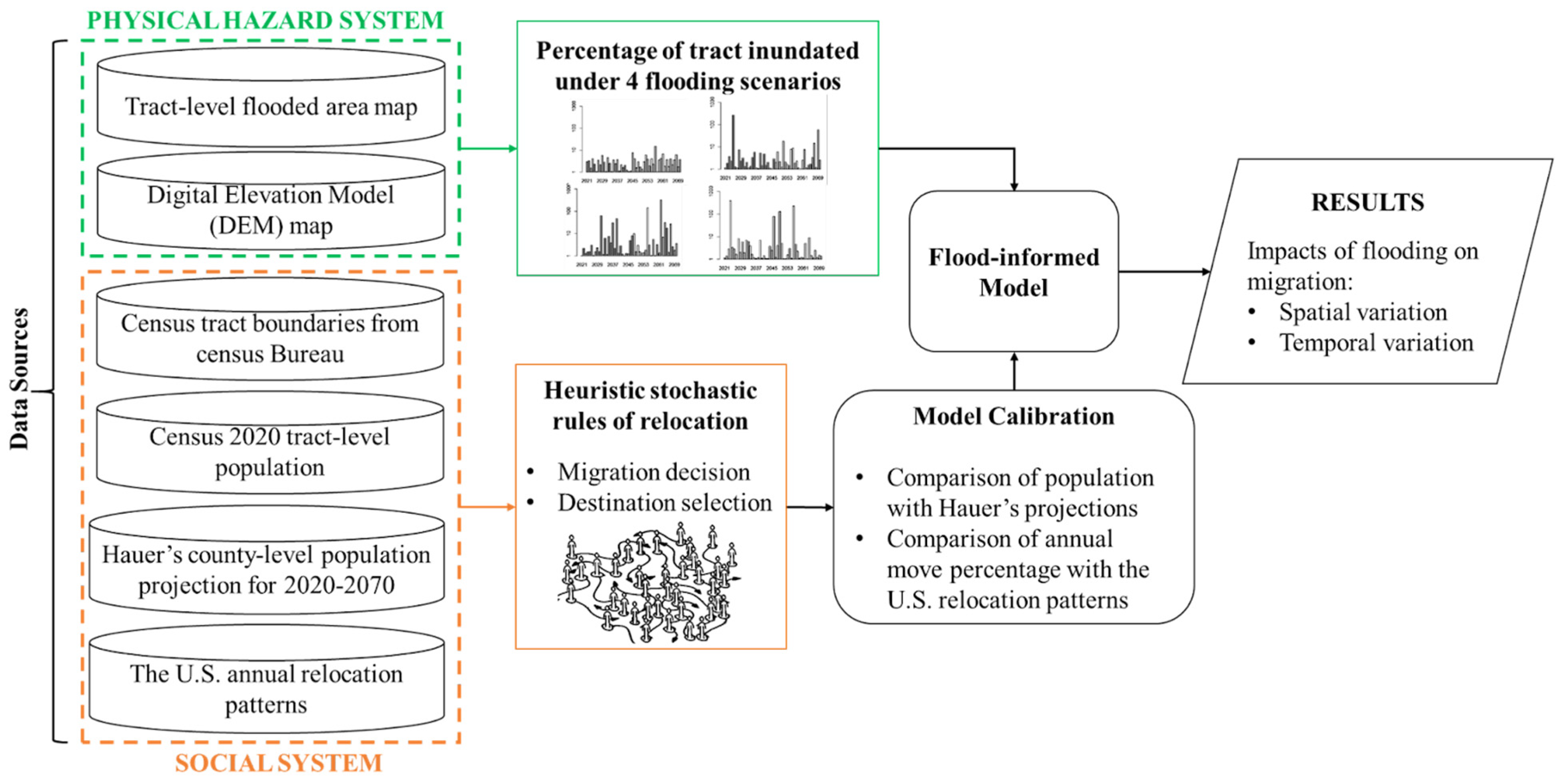
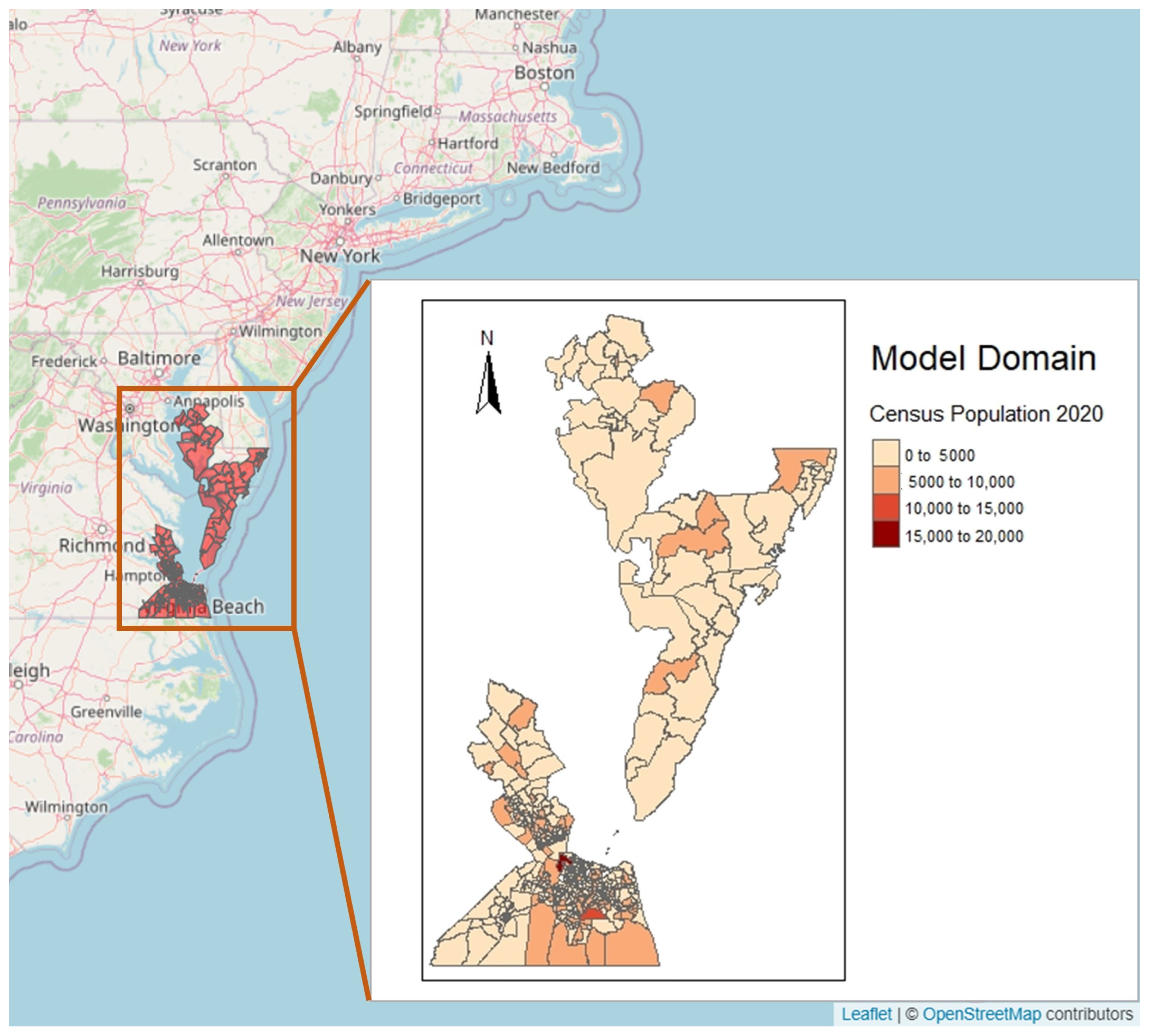
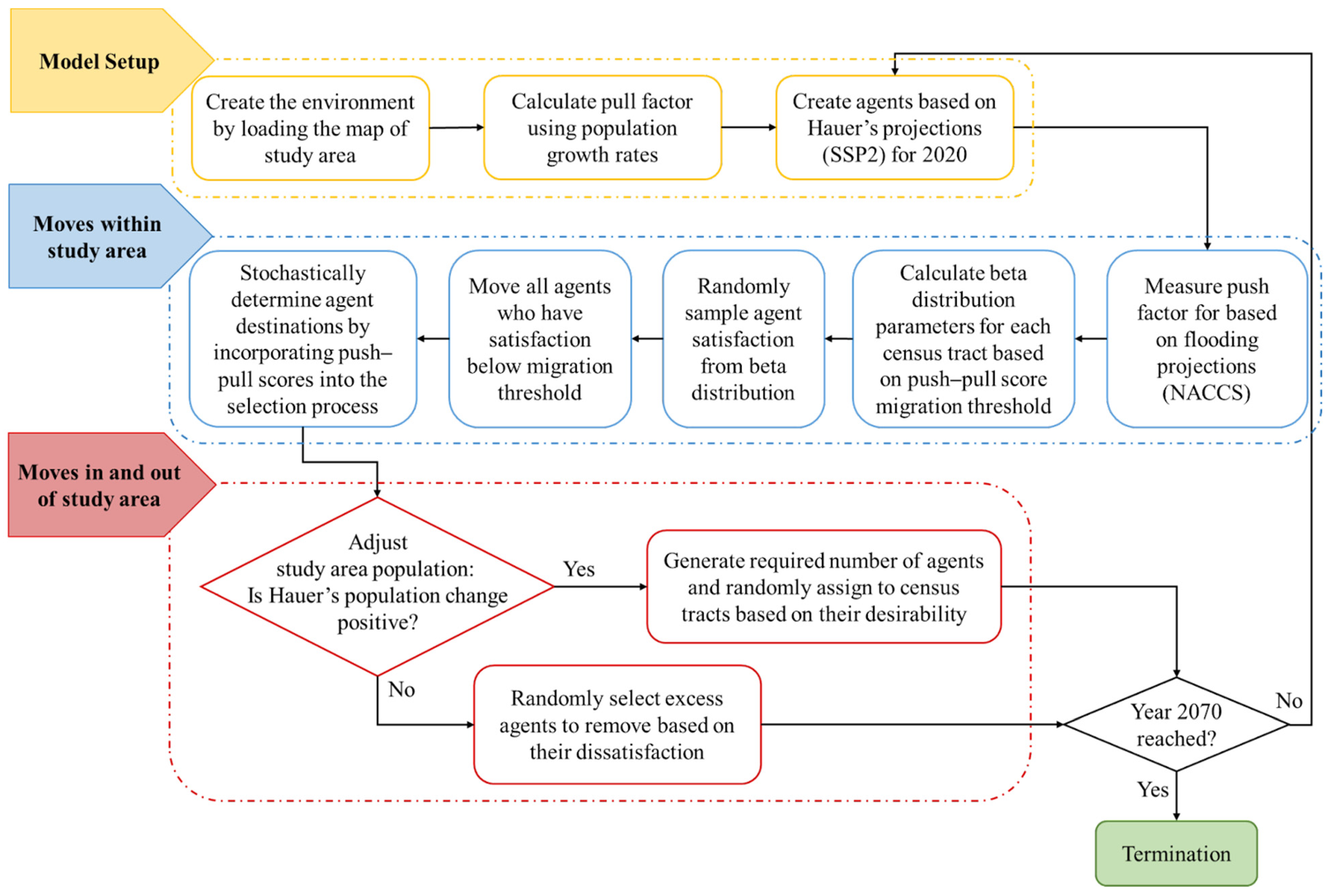
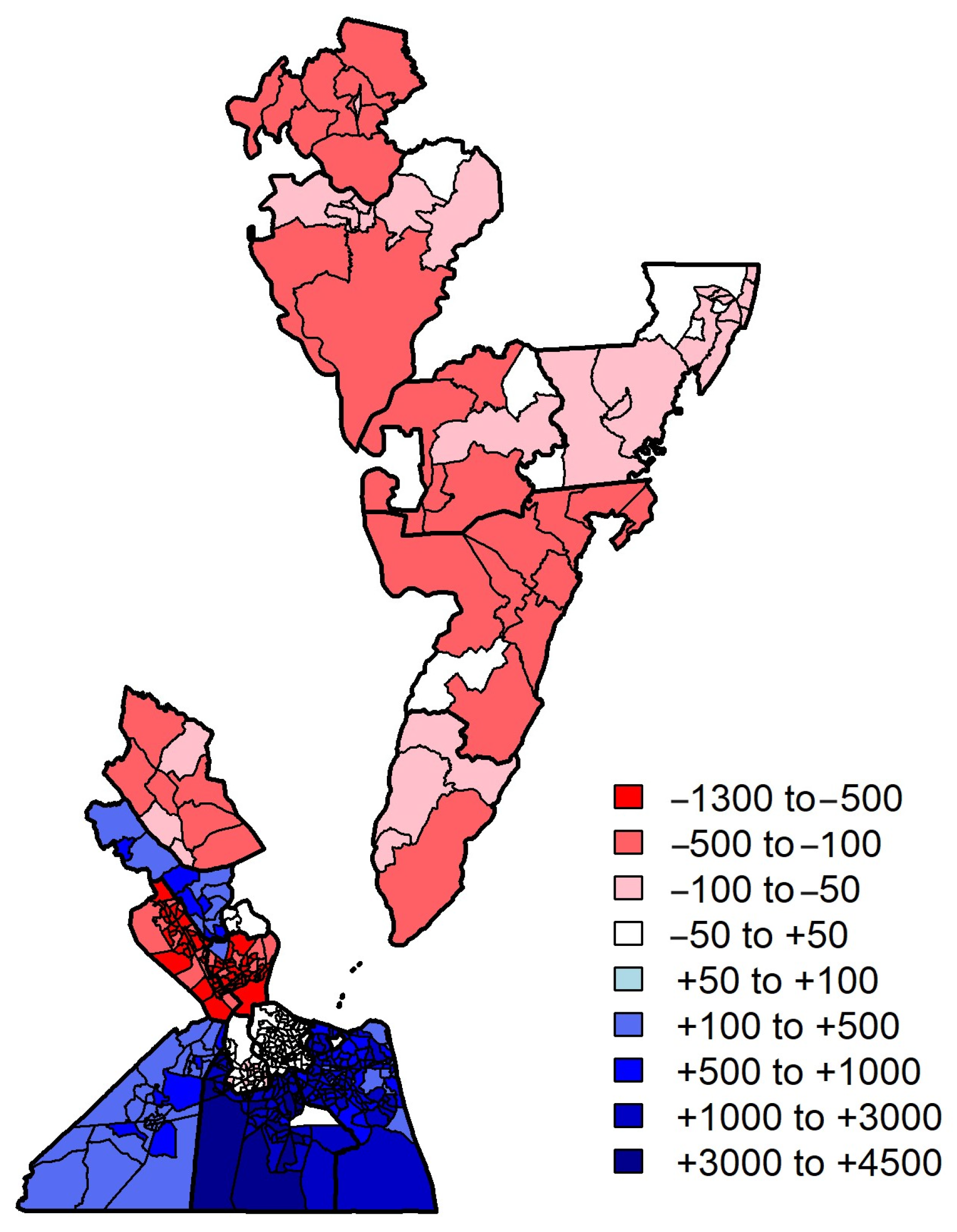



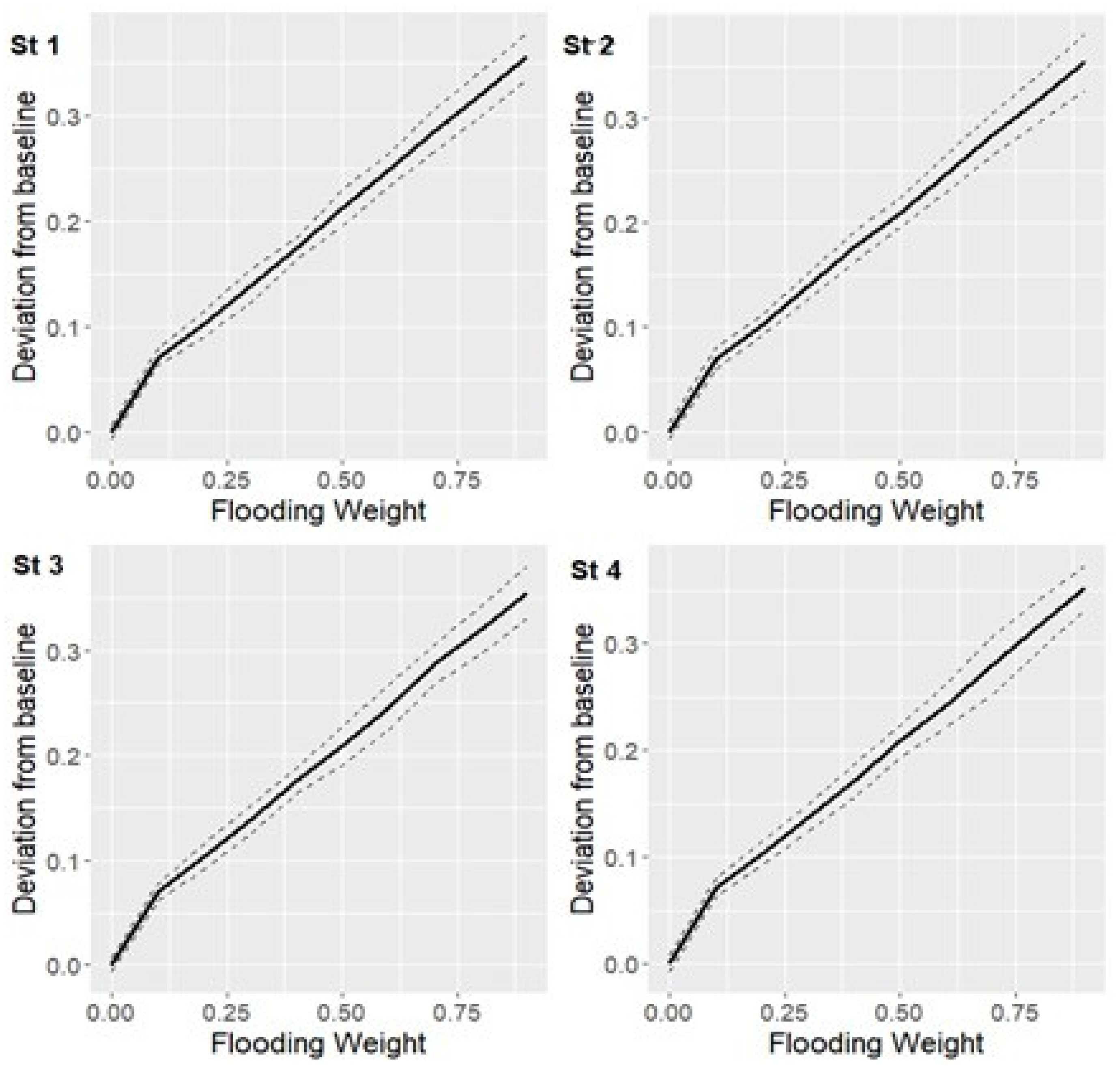
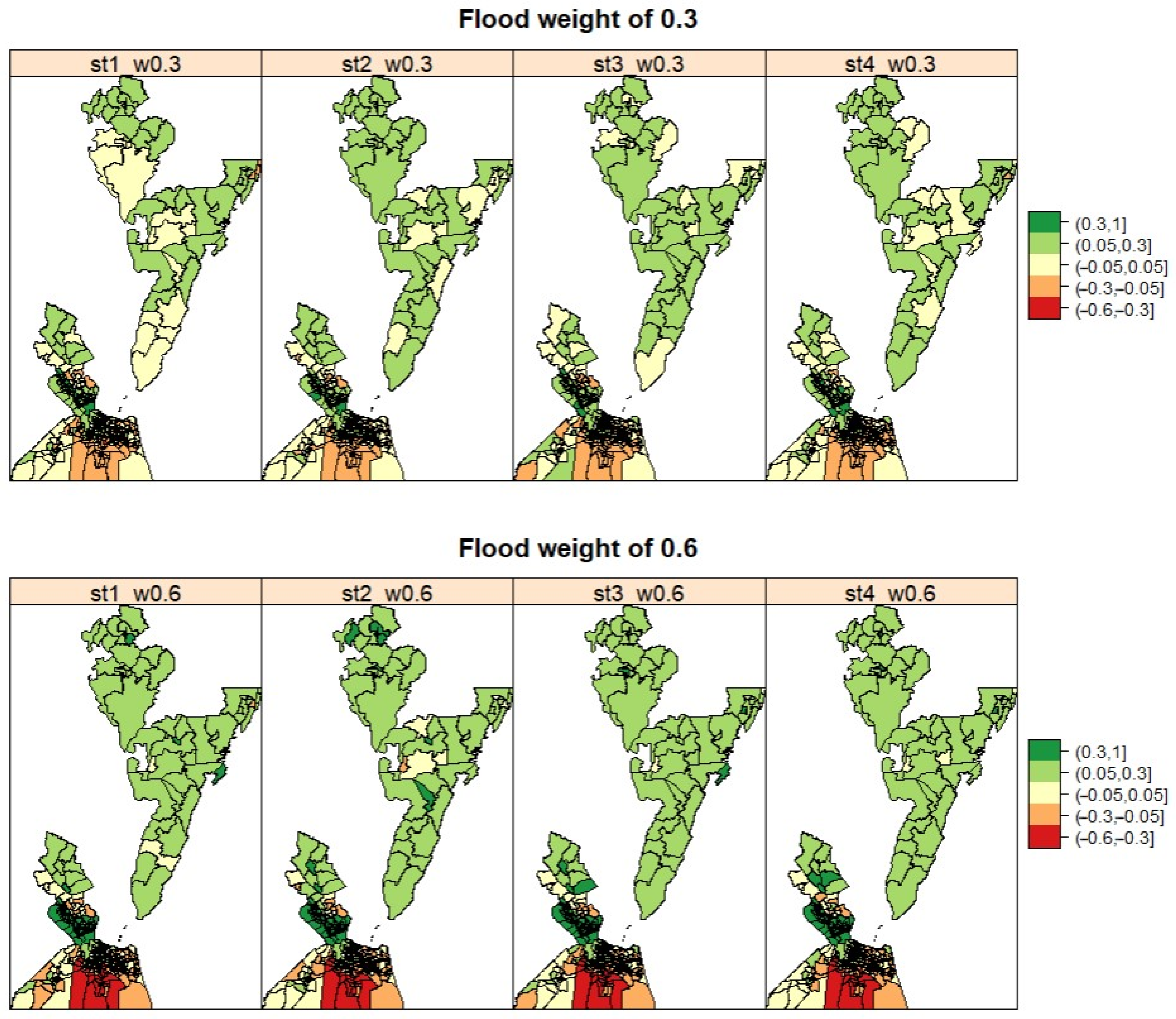
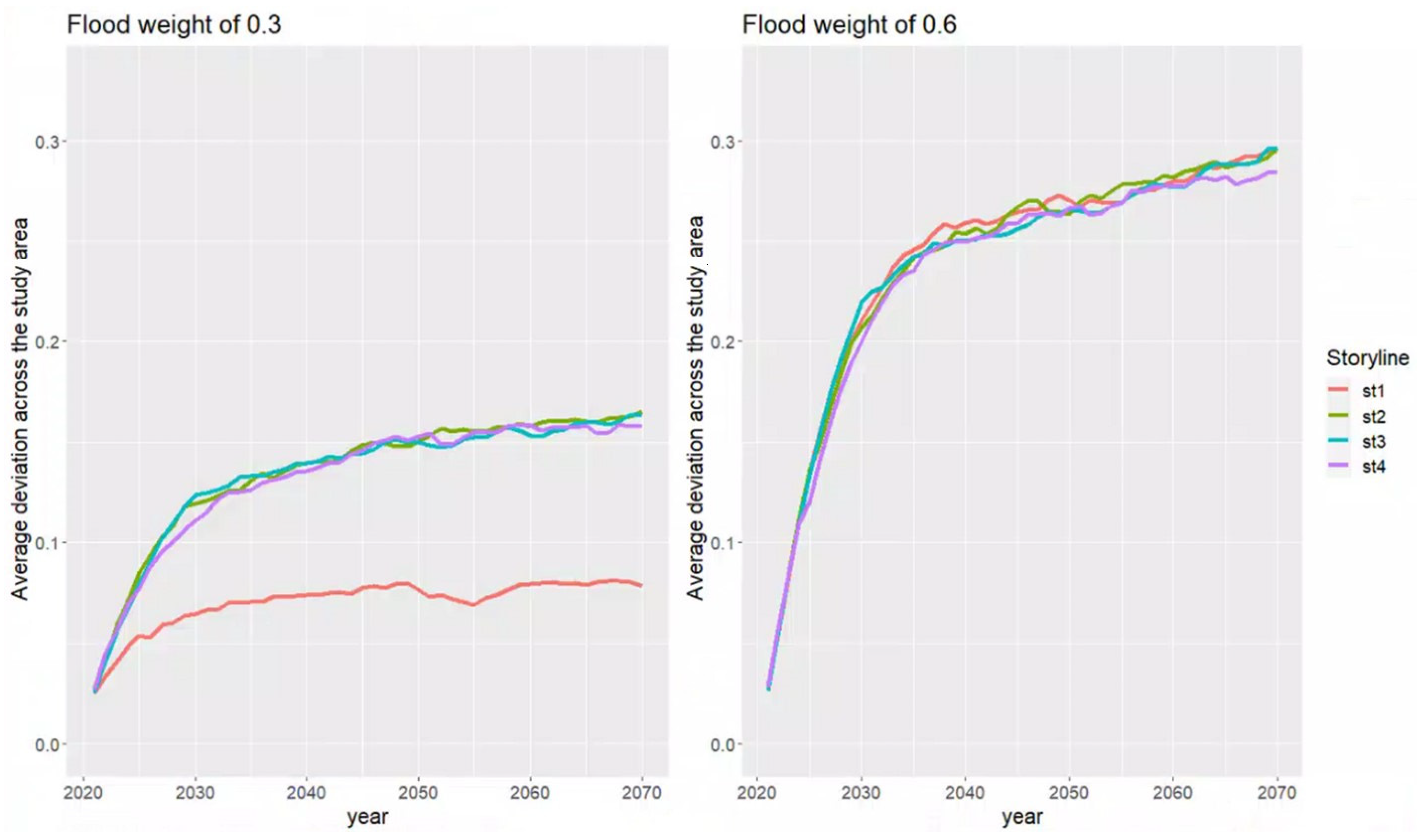
| Name/Symbol | Numeric Domain | Definition and Interpretation | |
|---|---|---|---|
| State Variables | Growth Rate (G) | (−1300, 4500) | Applies to census tracts; annual rate of population change (persons per year) derived from Hauer projections [64,65] for the study area. |
| Push–Pull Score (P) | (0, 1) | Applies to census tracts in baseline model; derived from state variable G and parameter . | |
| Satisfaction (S) | (0, 1) | Applies to agents; random variable sampled from a beta distribution. The beta distribution parameters are calculated from P of their current location and global parameters δ and υ | |
| Flood Extent (F) | (0, 1) | Applies to census tracts in the flood model (not included in the baseline model). Describes the percentage of a census tract inundated in each year y. | |
| Flood-influenced Push–Pull (P*) | (0, 1) | Applies to census tracts in flood model; derived from state variables P and F. | |
| Global Model Parameters | (0, 1) | Used to convert census tract growth rates into pull scores. Lower values result in more equal pull scores across census tracts; higher values result in more unequal pull scores. Calibrated value of 0.0006. | |
| δ | (0, 1) | Used to convert census tract P into beta distribution for sampling agent S. Higher values result in more discrepancy in S scores across high and low P census tracts. Calibrated value of 0.2. | |
| υ | (4, 20) | Used to convert census tract P into beta distribution for sampling agent S. Higher values result in more variance in S scores within a single census tract. Calibrated value of 15. | |
| MT | (0.1, 0.5) | Move threshold. Agents decide to move if S < MT. Higher values result in more agents moving during each model year. Calibrated value of 0.35. | |
| Parameter | Minimum Value | Maximum Value | Increment | Calibrated Value |
|---|---|---|---|---|
| 0.0002 | 0.0008 | 0.0001 | 0.0006 | |
| 0.2 | 0.8 | 0.2 | 0.2 | |
| 10 | 16 | 2 | 12 | |
| 0.25 | 0.40 | 0.05 | 0.35 |
Disclaimer/Publisher’s Note: The statements, opinions and data contained in all publications are solely those of the individual author(s) and contributor(s) and not of MDPI and/or the editor(s). MDPI and/or the editor(s) disclaim responsibility for any injury to people or property resulting from any ideas, methods, instructions or products referred to in the content. |
© 2024 by the authors. Licensee MDPI, Basel, Switzerland. This article is an open access article distributed under the terms and conditions of the Creative Commons Attribution (CC BY) license (https://creativecommons.org/licenses/by/4.0/).
Share and Cite
Nourali, Z.; Shortridge, J.E.; Bukvic, A.; Shao, Y.; Irish, J.L. Simulation of Flood-Induced Human Migration at the Municipal Scale: A Stochastic Agent-Based Model of Relocation Response to Coastal Flooding. Water 2024, 16, 263. https://doi.org/10.3390/w16020263
Nourali Z, Shortridge JE, Bukvic A, Shao Y, Irish JL. Simulation of Flood-Induced Human Migration at the Municipal Scale: A Stochastic Agent-Based Model of Relocation Response to Coastal Flooding. Water. 2024; 16(2):263. https://doi.org/10.3390/w16020263
Chicago/Turabian StyleNourali, Zahra, Julie E. Shortridge, Anamaria Bukvic, Yang Shao, and Jennifer L. Irish. 2024. "Simulation of Flood-Induced Human Migration at the Municipal Scale: A Stochastic Agent-Based Model of Relocation Response to Coastal Flooding" Water 16, no. 2: 263. https://doi.org/10.3390/w16020263
APA StyleNourali, Z., Shortridge, J. E., Bukvic, A., Shao, Y., & Irish, J. L. (2024). Simulation of Flood-Induced Human Migration at the Municipal Scale: A Stochastic Agent-Based Model of Relocation Response to Coastal Flooding. Water, 16(2), 263. https://doi.org/10.3390/w16020263







